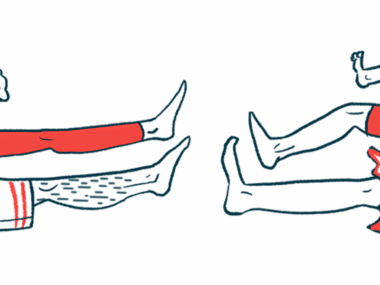4 Weeks of Nabiximols Found to Ease Spasticity in MS Pilot Study
Oral spray from cannabis plant improves patients' hand-to-mouth movements
Written by |

Four weeks of treatment with nabiximols — an oral spray containing compounds found in the cannabis plant — significantly reduced spasticity and generally improved arm and hand function in multiple sclerosis (MS) patients with moderate-to-severe spasticity, according to a small pilot study in Italy.
Notably, after nabiximols, patients showed faster and smoother movements on a “hand to mouth” task — which represents movements needed to carry out important daily tasks such as eating and drinking.
The results “reflect the actual potential of the treatment in terms of increased ability to perform activities essential for the independence of [people with MS],” the researchers wrote.
While these observed improvements in manual and finger dexterity did not reach thresholds considered clinically meaningful, previous evidence suggests longer treatment could have resulted in greater effects, the team noted.
Larger studies involving a longer treatment period are needed to confirm nabiximols’ benefits in upper limb function, they said.
The study, “Change in upper limb function in people with multiple sclerosis treated with nabiximols: a quantitative kinematic pilot study,” was published in the journal Neurological Sciences.
Cannabis products for treating MS
Muscle stiffness and involuntary spasms or twitches are common symptoms of MS, and are often referred to as spasticity. Spasticity of the upper limbs, or arms and hands, can slow movements, reduce manual dexterity, and result in clumsiness.
This “may negatively affect a wide range of [daily life activities] including manipulation of objects, writing, self-care skills (i.e., dressing, grooming, etc.) as well as occupational/school performance,” the researchers wrote.
While management of upper limb spasticity has proven challenging for many people with MS, there is limited evidence on the efficacy of recommended anti-spasticity oral therapies — most of them used for leg spasticity — on upper limb function.
Nabiximols, marketed by Jazz Pharmaceuticals, is an oral spray that contains equal parts of tetrahydrocannabinol (THC) and cannabidiol (CBD), two compounds found in the cannabis plant.
It is approved in Canada and most European countries, under the brand name Sativex, as an add-on medication to ease moderate-to-severe spasticity in people with MS when other treatments haven’t worked well enough. The treatment is administered in up to 12 sprays a day under the tongue or to the inside of the cheek.
However, it has not received approval in the U.S.
Nabiximols was shown to have a favorable safety profile and to reduce spasticity in several clinical trials, and its use has been subsequently supported by real-world studies.
To find out whether or not nabiximols might also help to improve upper limb motor function in MS patients, a team of researchers in Italy conducted a small, pilot study.
A total of 13 adults with MS — nine women and four men, with a mean age of 51.2 years — were included in the study. All had moderate-to-severe spasticity, classified as a patient-reported score of 4 or higher on a 0–10 scale.
The participants showed a lack of response to common and ongoing anti-spasticity treatments; none were using cannabis and/or other psychoactive drugs.
Most (84.6%) had a diagnosis of secondary progressive MS, while one patient had primary progressive MS, and the other had relapsing-remitting MS.
Participants received nabiximols for four weeks, or about one month, with a gradual dose increase until the optimal dose was reached. The mean dose of nabiximols was 5.6 sprays per day, according to patient-reported diaries.
Effect of nabiximols on arm, hand function
Results showed that four weeks of treatment significantly reduced patient-reported spasticity severity, which dropped from a mean score of 6.3 on the 0–10 scale at the study’s start to 4.1 after treatment.
All patients saw their spasticity reduced by at least 20%, which is the threshold set for clinical efficacy and for classifying a patient as a responder.
Nabiximols treatment also was associated with better performance in both the Nine-Hole Peg Test, which assesses finger dexterity, and the Box and Block test that measures gross manual skills.
These improvements reached statistical significance only for the Nine-Hole Peg Test, but both remained “below the threshold identified as representative of a clinically meaningful difference,” the researchers wrote.
Upper limb function also was assessed with a “hand to mouth” test, in which the movement’s speed, pattern, and stability were analyzed with a specialized camera-based system.
“Such movement is considered well representative of important ADLs [activities of daily living] like eating and drinking and was selected in previous studies which investigated upper limb functions in individuals affected by neurological diseases including MS,” the team wrote.
Patients required significantly less time to complete the “hand to mouth” movement after treatment compared with the study’s start (1.69 vs. 1.83 seconds; a 10% reduction).
The movement itself also became smoother, as indicated by significantly fewer movement units — “starts and “stops” — and changes in direction.
No patient discontinued treatment or reported adverse events.
These preliminary findings suggest nabiximols may ease spasticity and improve “the overall motor function of upper limb in [people with multiple sclerosis] with moderate to severe spasticity,” the team wrote.
“The use of quantitative techniques for human movement analysis may provide valuable information about changes originated by the treatment in realistic upper limb motor tasks involved in activities of daily living,” the researchers concluded.







